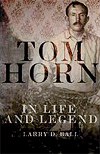
Tom Horn in Life and Legend, by Larry D. Ball, University of Oklahoma Press, Norman, 2014, $29.95
Yeah, but did he do it?
The sensational episodes of notorious Westerners’ lives often prompt us to skip to such a question. Did outlaw Jim Miller murder his grandparents? Did Rain-in-the-Face carve out Tom Custer’s heart at the Little Bighorn? Did Pat Garrett really kill Billy the Kid? Such is the case, too, with the subject of historian Larry Ball’s new book. Did Tom Horn snipe 14-year-old Wyoming rancher’s boy Willie Nickell in 1901?
Thankfully, author Larry Ball doesn’t let that episode dominate his biography of the cowhand, prospector, packer, scout, Pinkerton agent and “darkly enigmatic” range detective. Horn’s life was every bit as interesting as the circumstances that led to his death.
The primary obstacle Ball faced in separating real life from legend was Horn’s own autobiography, which is rife with distortions, errors, boasts and bald-faced lies. For example, he was not present when Ed Schieffelin struck silver ore in Tombstone, Arizona Territory, and Geronimo did not personally request Horn as a translator during council talks in Mexico’s Sierra Madre. However, Horn did join the Arizona silver rush—with little luck. He did land a job as a civilian packer/scout on a recommendation from the legendary Al Sieber. He did lead a company of Apache scouts into Mexico during General George Crook’s 1886 campaign to capture Geronimo. And Horn did serve as a translator at Geronimo’s final surrender. “I was not traveling on foot any more,” Horn recalled of that time in his life, “for I had a good horse, saddle, bridle and a Winchester rifle.” Those tools would serve him well in his future trade.
In the late 1880s, his Apache adventures behind him, Horn hired on as a range detective (read “hired gun”) in the Pleasant Valley War between Arizona cattlemen and sheepmen. That quasi-legal work prompted Horn to pursue a position as a Pinkerton agent out of Denver, which in turn led him north to investigate a brewing war on the open ranges. By the mid-1890s he had left the agency and was working directly for various Wyoming cattle barons, tasked with putting a halt to rustling and given considerable latitude as to his methods. Turns out killing was a favorite method, and his fearsome reputation put a further damper on illegal dealings.
Among the cattlemen was John Coble who was engaged in a bitter and violent range dispute with homesteader Kels Nickell, who had the audacity to fence the range and bring in sheep. On July 18, 1901, someone put a bullet into Nickell’s son Willie. Deputy U.S. Marshal Joe Lefors later coerced a highly disputed confession out of an intoxicated Horn, who was duly arrested, tried for the crime, convicted and hanged on November 20, 1903.
Yeah, but did he do it?
Ball devotes the last five chapters of his book to the murder, investigation and trial, Horn’s failed jailbreak and his execution, providing more than enough detail for readers to draw their own conclusions. The epilogue examines the origin of the legend of Tom Horn in the yellow press of his time and subsequent articles, books, films and TV shows. Ball’s aim is “to recover the historical Tom Horn,” and his book—some 15 years in the making—does that well.
—Dave Lauterborn




